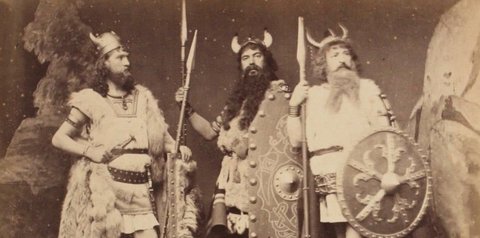Some observers read Angeli’s performance as political cosplay, intended to generate clicks to give the political message more visibility. It is unclear whether Angeli sought to further amplify his message through the metaphor of his bullhorn / megaphone (interestingly, cultural analyses of the role of social media compare blogs to bullhorns). Other media outlets wondered if the costume was supposed to represent a Viking or an “Indian,” whether the costume elements were ethnohistorically correct, and in how far Angeli committed cultural appropriation in wearing the costume. He himself tends to refer to elements of Native American mythology and cultural practice – to the American bison (who could run you over and trample you to death if you step in its path), and to the coyote, whom Native cultures revere as clever.

Federhaube der Plains-Kulturen mit Hörnern.
© Museum für Völkerkunde Dresden, Staatliche Kunstsammlungen Dresden.
In this interpretation, the pick-and-choose of cultural references becomes obvious: Indeed, some Native Plains cultures used bison horns on war bonnets up to the 20th century to acknowledge the deeds and spiritual powers of particularly accomplished warriors. Coyote the trickster plays an important role as a cultural (anti)hero in many tribal creation stories, as well as modern literature, causing mischief and throwing the world out of balance with wanton cunning and laziness.
However, more important than the question of cultural appropriation as such is how these references to Native peoples serve to spread political ideology. White Americans dressed as “Indians” are hardly a new phenomenon in political/cultural history – the colonists who stormed ships and dumped tea into Boston harbor in 1773 to protest British commerce regulations wore “Indian” garb. US cultural memory of the War of Independence fondly recalls that the rebel militias, without a chance against British regulars in pitched battles, learned to use the terrain and to “fight like Indians” in order to defeat the British.
The reference to Native Americans and illegal immigration is actually a traditional argument among Indigenous and liberal activists in the US to attack xenophobia: “Who is the illegal immigrant here, pilgrim?!” In Europe, especially in Germany, the notion of well-meaning “Indians” overrun by mobs of greedy foreigners has fueled anti-American argumentation since the late 19th century. It climaxed during National Socialism when the Nazis declared that, after the “Indians,” Germans were now the newest victims of American hypocrisy and brutality. Whenever US media protested against the Nazi persecution of Jews, Goebbels’ Propaganda machine retorted with references to “the fate of the Indian.” In 1941, the monthly magazine Koralle exemplified this notion by stating defiantly: “America, Keep Your own House in Order!”

Darsteller in Richard Wagners erster „Ring“ Aufführung, 1876.
© Foto: Emil Doepler.
During the 19th century, German nationalism had developed a bizarre mélange of ideas about warriorhood and indigeneity that rolled Native Americans, ancient Germanic tribes, and Nordic Vikings into one. Some people claimed Germans and Indians were soulmates, if not blood relatives with a shared primeval proto-Aryan ancestor. Similar notions and skewed historical comparison abound among the extreme German right today. Massacres against Native villages on the frontier and the near total extinction of the bison are likened to the Allied bombing campaign against German cities during the war. In the last 15 years, reference to North American colonial history serves to address a presumed overwhelming of “indigenous” Germans by immigrants (Überfremdung): The slogan “Indians couldn’t stop immigration, and now they live on reservations” appears in right-wing and conservative election campaigns, on Internet memes, bumper stickers, and t-shirts. Like “Indians,” Germans supposedly are on the verge of becoming a minority in their own country. The idea is not restricted to Germany, however – you’ll find the slogan and images in Austria, Switzerland, Italy, Hungary, and in debates on Brexit in the UK.
It seems that the extreme right uses the argument of Indians v. Immigrants strategically. The Norwegian assassin Breivik states in his manifesto (2011) that one cannot drag undecided people off the fence and make them commit to the nationalist cause by idolizing Hitler. Hitler, he says, is ‘burnt’ because his notion of supremacy based on race is no longer acceptable for most people. Instead, nationalists should take on a victim’s perspective and identify with resistance movements of minorities, i.e., they should refer to Sitting Bull and Crazy Horse as role models, rather than Hitler.
In this light, it is not surprising that some US gun-rights activists have begun to portray themselves as victims of oppressive gun legislation and claim that “Indians” lost their fight because they had no guns. The El Paso shooter commented in his manifesto (2019) that “Indians” couldn’t stop immigration and, therefore, Americans today had to learn from their plight and use violence against immigrants and refugees on the Mexican border (apparently, he wasn’t aware of the historical irony). So, Angeli’s bizarre attire continues a trend that has a longer tradition among nationalist groups but has taken hold in the US only recently. Despite all the ludicrous elements in his and others’ performances, then, this development is a sign of the increasing internationalization of right-wing extremism. It is a practice with a long history in Germany. The images of the storm on the Capitol are unsettling not least because the violence depicted there is also part of everyday life in contemporary Germany.